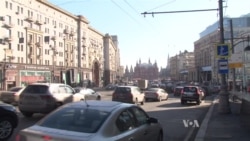Russia's automobile dealers had a bad year in 2015, as the country's economic woes kept buyers out of showrooms. But, at the opposite ends of the car market, some luxury vehicles and one low-end economy brand are seeing growth.
Car sales in Russia last year dropped by a whopping 36% as the economy shrank and inflation soared.
But the devalued ruble ironically made luxury cars cheaper in Russia than abroad and drove sales growth, as well-off Russians invested their unstable rubles in physical assets.
Luxury brand sales increased for some, such as Porsche, by as much as 12%. Lexus, a Toyota luxury model, saw sales grow 6%.
In a written response to questions, car maker Rolls-Royce’s dealer in Moscow told VOA the company’s exports to Russia increased 5% in 2015 and said it is “confident of another successful year” in Russia.
“Although our customers are not immune against the economic challenges,” the company wrote, “many of them felt that uncertain times are the right point for long-term investments.”
When asked about the luxury car market’s potential, and what is driving sales, Rolls-Royce said the “tough economic environment might be the right time for the luxury market.” The company added, “exchange rate jumps, economic instability stimulate people to consider investment channels.” Rolls-Royce concluded, “investment in luxury goods will always remain a way of effective solution.”
But not all high-end brands are doing well. Mercedes Benz saw sales drop by 15%, except for its mini Smart model, which sold 28% more units. BMW sales were down 23%.
At the mid-range, sales of Russia’s top three selling brands; Lada, KIA, and Hyundai, dropped 31%, 16%, and 10 percent, respectively.
Most mid-range and economy brands saw sales drop significantly. But at the lowest end of the market, Chinese brand Brilliance, a small player in Russia, increased sales by 26%.
“The prices have grown during the crisis, but I have decided to go in and have a look,” says car shopper Andrey Zemlianoy. “Chinese cars by their price are good.”
Unimotors, a Moscow dealer of Brilliance cars, says they expect sales to keep growing as the company builds on market conditions. “That's why it has a good future,” says head of sales Dzhaililov Timur, “as today many European brands are beyond the purchasing ability of the Russian customer, which is low due the exchange rate of over 70 Rubles per dollar. Many people change from European or American cars to Chinese cars.”
But more established Asian brands are not doing so well. China's Great Wall and South Korea's SsangYong saw sales drop 79% in 2015, among the sharpest falls in the car market.
As wages have fallen, many Russians have cut costs by taking public transport and scaling back plans to buy cars.
"Purchasing a new car is not one of my financial priorities,” says Moscow Metro employee Eldar Erzin, “because mine is not so old and because of the crisis. I'm pushing this off for now."
Engineer Vlad Zhdanov dreams of buying a luxury vehicle but says he will have to settle for a mid-range car like a Hyundai. "I'd like to buy a nice big car but, at the moment, I cannot. I need to start small."
Meanwhile, the steep drop in car sales has done little to alleviate the Russian capital's notorious traffic jams.
Mark Grinberg contributed to this report.







